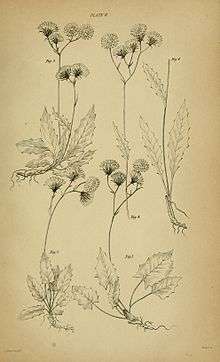Catharine Johnston
Catharine Johnston (née Charles; 1794–1871) was an English botanical illustrator who had a species of marine animal named in her honour.

Life and work
Catharine Charles was born in 1794[2] and was the daughter of William Claudius Charles, a surgeon who had worked in the West Indies.[3] On 23 November 1819, she married George Johnston,[4] a naturalist, and moved to Berwick-on-Tweed, where the couple resided permanently.[5]
Johnston took an active interest in the study of natural history.[5] She assisted her husband in his natural history investigations and illustrated his publications with scientific drawings.[5] She signed her works C. Johnston.[6] On 21 December 1831, she was made an "Extraordinary member" of the Berwickshire Naturalists' Club.[7] Her drawings assisted other notable scientists to further their research.[8]
_catharina_by_P_H_Gosse.jpg)
In 1853 Philip Henry Gosse named the marine species Tomopteris (Johnstonella) catharina in her honor stating:
The crystalline Johnstonella: I have pleasure of announcing a new animal of much elegance, which I believe to be of a hitherto unrecognised form. I shall describe it under the appellation of Johnstonella Catharina. (Plate XXV). ... I venture respectfully to appropriate to this marine animal, the surname and christian name of Mrs. Catharine Johnston, as a personal tribute of gratitude for the great aid which I have derived from her engravings in the study of zoophytology.[8]
References
| Wikimedia Commons has media related to Catharine Johnston. |
- Details - The botany of the Eastern Borders : with the popular names and uses of the plants, and of the customs and beliefs which have been associated with them / - Biodiversity Heritage Library. www.biodiversitylibrary.org. J. Van Voorst. 1853.
- DAVIS, PETER (28 July 2010). "George Johnston (1797–1855) of Berwick upon Tweed and the pioneers of marine biology in north-east England". Archives of Natural History. 22 (3): 349–369. doi:10.3366/anh.1995.22.3.349.
- Campbell, Thomas; Hall, Samuel Carter; Lytton, Edward Bulwer; Hook, Theodore Edward; Hood, Thomas; Ainsworth, William Harrison (1 January 1820). "Northumberland". The New Monthly Magazine. Vol. 12. p. 122. Retrieved 3 April 2015.
- "Marriages". Blackwood's Edinburgh Magazine. 6: 359. December 1819. Retrieved 3 April 2015.
- Platts, Elizabeth (1994). "In Celebration of the Ray Society Established 1844, and its founder George Johnston (1797 - 1855)" (PDF). The Ray Society Publication (163): 4. Archived from the original (PDF) on 7 April 2015. Retrieved 3 April 2015.
- "Johnston C." Database of Scientific Illustrators. University of Stuttgart. Retrieved 3 April 2015.
- "Extraordinary Members". History of the Berwickshire Naturalists' Club. 1: 2. 1834. Retrieved 3 April 2015.
- Gosse, Philip Henry (1853). A naturalist's rambles on the Devonshire coast. London: John Van Voorst. pp. 356–357. Retrieved 3 April 2015 – via biodiversitylibrary.org.